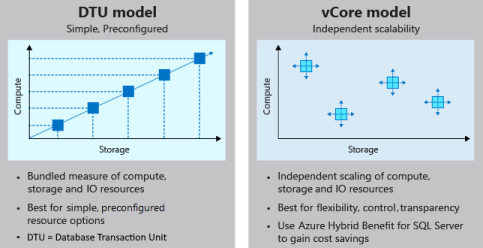Design for Azure SQL Database
Relational data is a type of structured data that has a shared schema. The data is stored in database tables with rows, columns, and keys, and used for application storage like e-commerce websites. As the CTO for Tailwind Traders, you're responsible for designing databases for Azure to support existing structured data on-premises. You're looking for a storage solution to support existing data and future relational data workloads initiated by the company.
Within the umbrella of the Azure SQL platform, there are many AI-ready deployment options and choices to consider. This video reviews five options that give you the flexibility to get and pay for exactly what you need in your storage solution.
Azure SQL Database
In this unit, we look at Azure SQL Database and SQL Database elastic pools. In the following units, we examine SQL Server on Azure Virtual Machines, along with Azure SQL Managed Instance and instance pools.
Azure SQL Database is a PaaS deployment option of Azure SQL that abstracts both the OS and the SQL Server instance. An Azure SQL database is a fully managed service. You don't have to deal with complex database tasks like configuring and managing high availability, tuning, and backups. The service automatically upgrades each SQL database to run the most recent version of SQL Server. You get the latest SQL Server capabilities without having to perform manual updates.
Things to know about Azure SQL Database
Review the following characteristics of the SQL Database deployment option:
It's a highly scalable, intelligent, relational database service built for the cloud with the industry's highest availability.
SQL Database is the only deployment option that supports scenarios that require large databases (currently up to 100 TB) or autoscaling for unpredictable workloads (serverless).
You can create a SQL Database elastic database pool, where all databases in the pool share the same set of compute and storage resources. Each database can use the resources it needs, within the limits you set, depending on current load.
There are two primary pricing options for SQL Database: DTU and vCore. A serverless option is also available for a single database.

vCore: A vCore is a virtual core. You choose the number of virtual cores and have greater control over your compute costs. This option supports the Azure Hybrid Benefit for SQL Server and reserved capacity (pay in advance).
DTU: A DTU (Database Transaction Unit) is a combined measure of compute, storage, and I/O resources. The DTU option is an easy, preconfigured purchase option.
Serverless: A compute tier for single databases in SQL Database. The serverless model automatically scales compute, based on workload demand, and bills only for the amount of compute used.
Business scenario
Let's explore a business scenario for Azure SQL Database. AccuWeather has been analyzing and predicting the weather for more than 55 years. The company chose the Azure platform for its big data, machine learning, and AI capabilities. AccuWeather wants to focus on building new models and applications, not on managing databases. The company chose SQL Database to use with other services, like Azure Data Factory and Azure Machine Learning to quickly and easily deploy new internal applications to make sales and customer predictions.

Things to consider when using Azure SQL Database
Consider how Azure SQL Database can be included in your relational data storage plan for Tailwind Traders:
Consider vCore pricing. (Microsoft recommended) Select compute and storage resources independently for multiple SQL databases or an elastic database pool. Use Azure Hybrid Benefit for SQL Server or reserved capacity (pay in advance) to save money. You control the compute and storage resources that you create and pay for.
Consider DTU pricing. Choose this easy, preconfigured purchase plan for a bundled measure of compute, storage, and I/O resources to support multiple SQL databases. This option isn't available for Azure SQL Managed Instance.
Consider serverless option. Use the serverless compute tier for a single SQL database. You're billed only for the amount of compute used.
Consider elastic database pools. Buy a set of compute and storage resources to share among all SQL databases in an elastic pool. For more information, see SQL elastic pools.